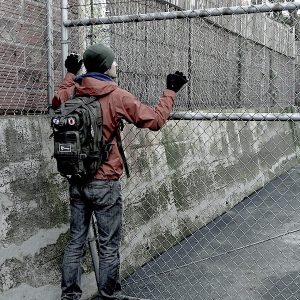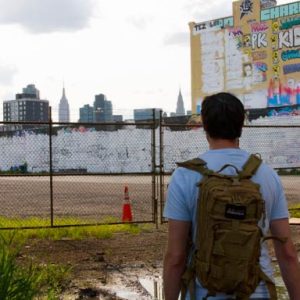Welcome to the concrete jungle! In this bustling world of skyscrapers and subways, we often find ourselves wrapped up in the fast-paced rhythm of urban life. But amidst the hustle and bustle, it’s essential to acknowledge the need for survival skills tailored to city living. From dodging relentless traffic to navigating through potential emergencies, being prepared is the ultimate key to thriving in the metropolis. In this article we look at complete urban survival strategies and how you can stay safe in your city should a natural disaster or civil unrest occur.
Check out these awesome urban survival kits by clicking here.
Complete Urban Survival Strategies: Staying Safe in the City
 Survival. It’s a word that usually conjures up images of rough terrains and wild adventures. But let’s shift the spotlight to our very own urban jungles. Cities, too, have their fair share of challenges and risks, just of a different kind. Picture this: towering buildings, crowded streets, and the constant hum of energy. Sounds thrilling, right? But with great excitement comes great responsibility. Living in the city means being prepared for anything – natural calamities, power outages, civil unrest, and more. Don’t worry; we’re not trying to scare you! We’re here to arm you with the knowledge and skills you need to take on the urban survival challenge like a pro.
Survival. It’s a word that usually conjures up images of rough terrains and wild adventures. But let’s shift the spotlight to our very own urban jungles. Cities, too, have their fair share of challenges and risks, just of a different kind. Picture this: towering buildings, crowded streets, and the constant hum of energy. Sounds thrilling, right? But with great excitement comes great responsibility. Living in the city means being prepared for anything – natural calamities, power outages, civil unrest, and more. Don’t worry; we’re not trying to scare you! We’re here to arm you with the knowledge and skills you need to take on the urban survival challenge like a pro.
The Importance of Being Prepared in the City
“Preparedness” might sound like a daunting term, but it’s more like your secret superpower. In a city, where every second counts, being prepared can make all the difference. Not just for your own safety, but for the well-being of everyone around you too. Imagine knowing how to respond confidently when disaster strikes – that’s the level of empowerment we’re talking about! From knowing the nearest emergency exits to having a handy survival kit, preparedness turns you into the hero of your urban adventure.
Let’s face it; the city can be a bit unpredictable. You never know when you might face unexpected challenges. Whether it’s a sudden blackout, a flash flood, or even a lost wallet in the middle of nowhere, being prepared equips you to handle these situations with ease.
Alright, let’s get down to business. In the coming sections, we’ll arm you with a comprehensive arsenal of urban survival strategies. Here’s what’s in store:
- Assessing Urban Risks: We’ll take a close look at the potential dangers lurking in the city shadows. From natural disasters to human-made crises, understanding the risks is the first step towards staying ahead of the game.
- Building a City-Specific Preparedness Plan: Prepare to be your own urban architect! We’ll show you how to create a personalized survival plan that fits right into your city lifestyle. This includes crafting a clear-cut evacuation strategy, identifying safe havens, and establishing reliable communication channels.
- Assembling an Urban Survival Kit: Every superhero needs a utility belt, and you’ll have your own urban survival kit. We’ll reveal the essential items to pack in your trusty kit – from basic necessities to nifty gadgets that’ll make MacGyver jealous!
- Developing Urban Survival Skills: This section is all about leveling up. We’ll guide you through acquiring must-have urban survival skills like first aid, navigation, self-defense, and even street smarts.
Get ready to embark on your urban survival journey. Our goal is to equip you with the knowledge and confidence to conquer any challenges that come your way. So buckle up, keep your senses sharp, and let’s dive into the concrete wilderness together! Stay tuned for the upcoming sections packed with easy-to-follow tips and tricks that’ll make you the urban survival expert you were destined to be. Let the adventure begin!
Check out these awesome urban survival kits by clicking here.
Understanding Urban Risks
 When it comes to urban survival, knowledge is your best weapon. As you venture deeper into the cityscape, it’s crucial to be aware of the unique risks that urban environments present. From the relentless hustle to the hidden dangers, we’ll shine a light on the potential hazards you might encounter, ensuring you’re fully prepared for whatever the city throws your way.
When it comes to urban survival, knowledge is your best weapon. As you venture deeper into the cityscape, it’s crucial to be aware of the unique risks that urban environments present. From the relentless hustle to the hidden dangers, we’ll shine a light on the potential hazards you might encounter, ensuring you’re fully prepared for whatever the city throws your way.
Identifying Urban Risks: Crime, Traffic, Pollution, etc.
In the urban jungle, there’s a lot more than meets the eye. While the bright lights and towering buildings paint a picture of excitement, it’s essential to be mindful of potential dangers. Crime rates can fluctuate from one neighborhood to another, making it vital to stay informed about the safety of your surroundings. Understanding the trends in your area can help you take precautions and avoid risky situations.
But it’s not just criminal activity you need to be vigilant about. Traffic congestion is an ever-present issue in cities, causing not only delays but also accidents that can put you in harm’s way. Becoming a savvy pedestrian and mastering the art of crossing busy streets is part of your urban survival training.
Let’s not forget the silent threats – pollution and environmental hazards. Urban areas are notorious for their air and noise pollution, which can have adverse effects on your health over time. Being aware of pollution levels and taking measures to protect yourself can go a long way in ensuring your well-being in the city.
Understanding Potential Natural Disasters in Cities
When you think of natural disasters, the city might not be the first thing that comes to mind. However, urban areas are not immune to Mother Nature’s fury. Earthquakes, floods, and wildfires are all potential hazards that can strike urban environments unexpectedly. The impact of these disasters can be amplified by the dense population and intricate infrastructure, leading to devastating consequences.
Staying informed about the historical occurrence of natural disasters in your city is crucial. While some areas might be more susceptible to flooding, others might lie on fault lines that increase the risk of earthquakes. Understanding these patterns will help you develop a more robust preparedness plan tailored to the specific threats you might face.
The Impact of Overpopulation and Infrastructure Challenges
 Cities have an undeniable allure, drawing people from all walks of life. The result? Overpopulation. While city living offers numerous opportunities, it also comes with its share of challenges. Overcrowded spaces can lead to increased competition for resources and limited access to essential services during emergencies.
Cities have an undeniable allure, drawing people from all walks of life. The result? Overpopulation. While city living offers numerous opportunities, it also comes with its share of challenges. Overcrowded spaces can lead to increased competition for resources and limited access to essential services during emergencies.
Additionally, the infrastructure that supports the city’s functioning can be strained during crises. Power outages, water supply disruptions, and communication breakdowns can compound the effects of any disaster. Being prepared means considering the possible strain on urban resources and finding alternative solutions when the usual systems fail.
Importance of Knowing Local Emergency Services and Resources
Picture this: an emergency strikes, and you’re left feeling helpless. It’s a situation no one wants to find themselves in. Familiarizing yourself with local emergency services and resources is a crucial step in your urban survival journey. Know the numbers to call in case of emergencies, such as police, fire department, and medical assistance. Understanding the nearest evacuation centers and community shelters can be a lifesaver when you need a safe haven.
Beyond official services, tap into local community networks and organizations that might offer support during difficult times. Neighbors helping neighbors is a powerful urban survival strategy that fosters resilience and solidarity.
In conclusion, comprehending urban risks is the first step towards mastering the art of urban survival. Being street-smart means being aware of potential dangers, understanding the city’s vulnerabilities, and knowing where to turn for assistance when the unexpected strikes. Armed with this knowledge, you’re ready to take on the urban jungle with confidence. Stay tuned for the upcoming sections, where we’ll delve into crafting a personalized preparedness plan and assembling your urban survival kit. Let’s equip you to thrive in the city and conquer any challenge that comes your way!
Check out these awesome urban survival kits by clicking here.
Preparing Your Urban Survival Kit
Congratulations, urban adventurer! Now that you’re well-versed in the risks of the city jungle, it’s time to assemble your ultimate urban survival kit. Think of it as your trusty sidekick, ready to lend a helping hand in any crisis. From the basics to the city-specific essentials, we’ll guide you through creating a customized, compact, and discreet kit that’ll have your back when you need it most.
Check out these awesome urban survival kits by clicking here.
Creating a Customized Urban Survival Kit
 One size doesn’t fit all, and that’s especially true for survival kits. Your urban survival kit should be tailored to your specific needs and the unique challenges of your city. Consider factors like the weather, potential disasters, and the duration you might need to rely on your kit. Personalize it to cater to any medical conditions or specific requirements you might have.
One size doesn’t fit all, and that’s especially true for survival kits. Your urban survival kit should be tailored to your specific needs and the unique challenges of your city. Consider factors like the weather, potential disasters, and the duration you might need to rely on your kit. Personalize it to cater to any medical conditions or specific requirements you might have.
Remember, this kit is all about self-reliance. The goal is to have the essentials at your fingertips, giving you the confidence to face any situation head-on. So let’s dive into the must-have items that will form the backbone of your urban survival kit.
Essential Items: Water, Non-Perishable Food, First Aid, etc.
Hydration is key to survival, so start by stocking up on water. Aim for at least one gallon of water per person per day, with a minimum of three days’ worth on hand. Stay hydrated, stay strong!
Next up, non-perishable food items. Think energy bars, canned goods, and dehydrated meals. They might not be gourmet, but they’ll keep you fueled and ready for action.
A comprehensive first aid kit is a non-negotiable component of your urban survival kit. Bandages, antiseptic wipes, pain relievers, and any necessary prescription medications should be included. Don’t forget any personal medical information, such as allergies or medical conditions.
Check out this range of non-perishable food by clicking here.
Check out this range of first aid kits by clicking here.
Check out this range of water filtration devices by clicking here.
Including Urban-Specific Items: N95 Masks, Flashlights, Maps, etc.
 In the city, you’ll face a different set of challenges than you would in the great outdoors. Urban survival calls for urban-specific gear. Start with N95 masks to protect yourself from pollution, pathogens, and other airborne hazards. Breathe easy, even in the midst of the city’s chaos.
In the city, you’ll face a different set of challenges than you would in the great outdoors. Urban survival calls for urban-specific gear. Start with N95 masks to protect yourself from pollution, pathogens, and other airborne hazards. Breathe easy, even in the midst of the city’s chaos.
Navigating through dimly lit streets or during a power outage demands a reliable flashlight. Invest in a sturdy, compact flashlight with long battery life to keep darkness at bay.
Now, here’s a tool that separates the savvy city slickers from the rest – maps! Include detailed maps of your city and surrounding areas in your kit. While GPS might be your go-to, technology can fail when you least expect it. A trusty map ensures you’ll never lose your way.
Check out this range of N95 masks by clicking here.
Check out this range of flashlights by clicking here.
Staying Compact and Discreet with Your Kit
In a city where space is a luxury, size matters! Your urban survival kit should be compact and easy to carry. Opt for a durable backpack or a sleek duffel bag to hold your essentials.
Discretion is the name of the game. While being prepared is crucial, drawing unnecessary attention is not. Keep your kit inconspicuous and avoid flashy colors or labels that scream “survivalist.” Blend in with the crowd while being the most prepared person in the vicinity!
Consider the weight of your kit, too. You don’t want to be weighed down by unnecessary bulk. Focus on high-quality, multipurpose items that serve multiple functions without adding extra heft.
Congratulations! You now have the blueprint for your very own urban survival kit. But remember, preparedness is not a one-and-done deal. Regularly review and update your kit to ensure it stays up-to-date and meets your changing needs. Stay tuned for the next section, where we’ll explore developing essential urban survival skills. Armed with both knowledge and a well-prepared kit, you’ll be ready to embrace the city with confidence, knowing you can conquer any obstacle that comes your way!
Navigating Urban Mobility and Transportation
 Congratulations, urban survivor! Now that you’re equipped with your personalized urban survival kit, it’s time to tackle the concrete labyrinth with finesse. In this section, we’ll guide you through mastering urban navigation, maneuvering public transportation during emergencies, outsmarting traffic jams, and even choosing the perfect urban survival vehicle. Let’s hit the road and conquer the city!
Congratulations, urban survivor! Now that you’re equipped with your personalized urban survival kit, it’s time to tackle the concrete labyrinth with finesse. In this section, we’ll guide you through mastering urban navigation, maneuvering public transportation during emergencies, outsmarting traffic jams, and even choosing the perfect urban survival vehicle. Let’s hit the road and conquer the city!
Urban Navigation Tips: Knowing Streets, Alleys, and Shortcuts
In the urban jungle, knowing your way around is a superpower. Familiarize yourself with the layout of your city – the main streets, alleys, and shortcuts that can help you avoid congestion or even serve as alternative escape routes during emergencies.
Embrace the art of landmark recognition. Identifying prominent buildings or street art can serve as visual cues to keep you on track when GPS signals wane. Make a mental map of key locations, ensuring you won’t be left scratching your head when the city throws you a curveball.
If you’re feeling adventurous, take a stroll through the less-traveled alleys. Not only will you uncover hidden gems, but you’ll also become a street-smart urban explorer, ready for any twists and turns that come your way.
Check out these maps for your urban location by clicking here.
Check out these GPS units by clicking here.
Public Transportation Strategies for Emergencies
When the city’s pulse quickens, public transportation can be a lifeline. Familiarize yourself with the various public transit options available in your city, including buses, subways, and trains. Know the routes and schedules like the back of your hand.
During emergencies, public transportation might be your best escape route. Plan ahead and identify multiple ways to reach essential locations using public transit. In times of crisis, congested roads may become impassable, but well-organized public transportation can whisk you away to safety.
Keep your transit card topped up and ready to go at all times. Having a backup card or alternate payment methods can save you from being stranded in critical situations.
Handling Traffic Jams and Gridlock Situations
Ah, traffic jams – the bane of city life! To navigate traffic snarls like a pro, stay informed about peak hours and road closures in your city. Avoiding these times can save you from getting caught in the gridlock.
 Practice patience and maintain a cool head. Road rage won’t get you anywhere fast. Instead, use the time stuck in traffic to listen to informative podcasts or explore the latest urban survival tips – multitasking at its finest!
Practice patience and maintain a cool head. Road rage won’t get you anywhere fast. Instead, use the time stuck in traffic to listen to informative podcasts or explore the latest urban survival tips – multitasking at its finest!
Choosing the Right Urban Survival Vehicle
Sometimes, the best way to navigate the urban jungle is with your own wheels. Choosing the right urban survival vehicle depends on your specific needs and circumstances. If you prefer maneuverability and ease of parking, a compact car might be the way to go. On the other hand, an all-terrain vehicle could be a worthy investment if your city is prone to extreme weather conditions.
Consider the fuel efficiency and range of your vehicle, especially during emergencies when gas stations might be scarce. Hybrids or electric vehicles might be environmentally friendly choices that provide added peace of mind.
Remember, your vehicle can also serve as an extension of your survival kit. Keep essential items like a first aid kit, emergency supplies, and a few non-perishable snacks in your car at all times.
As you navigate the urban mobility landscape, be adaptable and open to exploring new routes and transportation methods. Preparedness is not just about having a plan; it’s about being resourceful and creative in the face of challenges.
Congratulations! You’ve now unlocked the secrets to urban mobility and transportation. With your navigational prowess, public transit know-how, and the perfect urban survival vehicle, you’re ready to take on any traffic jam or tricky alley that comes your way. In the final section, we’ll delve into honing crucial urban survival skills that will elevate you to the status of a true urban survivor. So buckle up and enjoy the ride – you’ve got this!
Securing Your Urban Residence
Home is your sanctuary in the urban chaos, and securing it is paramount to your safety and well-being. In this section, we’ll explore strategies for fortifying apartment and condo living spaces, implementing urban home security systems, creating a safe room, and preparing for power outages and utility disruptions. With these tactics in place, your urban residence will be your fortress in the heart of the city.
Fortifying Apartment and Condo Living Spaces
Living in an apartment or condo doesn’t mean you have to compromise on security. Start by assessing your residence’s vulnerabilities. Check all entry points, such as doors and windows, for any potential weak spots.
Invest in robust locks for your doors and consider adding a security bar to reinforce them further. Install peepholes to identify visitors before opening the door, giving you an added layer of protection against unwanted surprises.
Get to know your neighbors. Building a strong sense of community can enhance security in shared living spaces. Neighbors looking out for each other can quickly spot and report any suspicious activity.
Check out these home defence kits by clicking here.
Urban Home Security Systems and Strategies
 Embrace modern technology to fortify your urban residence. Install a reliable home security system that includes surveillance cameras, motion sensors, and an alarm system. A visible security camera can act as a deterrent, while an alarm system can alert you and the authorities of any potential threats.
Embrace modern technology to fortify your urban residence. Install a reliable home security system that includes surveillance cameras, motion sensors, and an alarm system. A visible security camera can act as a deterrent, while an alarm system can alert you and the authorities of any potential threats.
Opt for a system with remote access, enabling you to monitor your home even when you’re away. Some systems even integrate with smartphone apps, putting home security at your fingertips.
Smart home devices can further enhance your urban security. Consider smart locks, which allow you to control access to your home digitally. Smart lighting systems can create the illusion of occupancy even when you’re out, deterring potential burglars.
Check out these home security systems by clicking here.
Creating a Safe Room in Your Residence
A safe room, also known as a panic room, can be a lifesaver during emergencies. Designate a secure area in your residence, preferably with reinforced walls and a sturdy door. This room should ideally have no windows and be stocked with essential supplies from your urban survival kit.
In case of a home invasion or other dangerous situations, retreat to your safe room, lock yourself in, and call for help. Having a means of communication, such as a cell phone or a two-way radio, can keep you in contact with the outside world.
Check out these essential safe room supplies by clicking here.
Preparing for Power Outages and Utility Disruptions
In the city, power outages and utility disruptions can occur unexpectedly. Be prepared with alternative sources of power, such as portable generators or solar-powered chargers for your devices.
Keep a supply of candles, flashlights, and batteries on hand for lighting during blackouts. Battery-operated fans can provide relief during sweltering summers when the AC is out.
During utility disruptions, access to clean water can be affected. Consider storing a reserve of water or invest in a portable water filtration system to ensure you have a safe supply.
By securing your urban residence, you’re not only protecting your physical belongings but also creating a sense of peace and security in your home. With a fortified living space, a robust home security system, a designated safe room, and preparations for power outages, you’ll be ready to face any urban challenges that come your way.
Check out these power supply options which are ideal if you have a power outage by clicking here.
Congratulations! You’re now a master at securing your urban residence. The final section will reveal essential urban survival skills that will elevate your preparedness to legendary levels. Stay tuned and continue your journey to becoming a true urban survivor!
Urban Foraging and Food Security
 In the concrete sprawl of the city, food security becomes a vital aspect of urban survival. Knowing how to find and utilize edible urban plants, implement food storage solutions, build a small-scale urban garden, and tap into community resources will ensure you never go hungry even amidst the hustle and bustle of urban life.
In the concrete sprawl of the city, food security becomes a vital aspect of urban survival. Knowing how to find and utilize edible urban plants, implement food storage solutions, build a small-scale urban garden, and tap into community resources will ensure you never go hungry even amidst the hustle and bustle of urban life.
Finding and Harvesting Edible Urban Plants
The city might seem like an unlikely place for foraging, but surprisingly, edible plants can be found in the most unexpected corners. Parks, abandoned lots, and even sidewalk cracks can harbor nutritious treasures waiting to be discovered.
Research and educate yourself on the edible plants native to your area. Learn to recognize them by their leaves, flowers, and fruits. Be cautious and avoid consuming any plant unless you’re absolutely certain of its identity and edibility.
Common urban edible plants include dandelions, wild garlic, purslane, and chickweed. These resilient plants thrive in urban environments and can be a valuable addition to your diet in times of need.
Check out this guide on urban foraging by clicking here.
Food Storage Solutions for Urban Dwellers
Food storage is a crucial part of urban food security. In a city where space is at a premium, creative solutions are necessary. Utilize airtight containers to store dry goods and snacks, keeping them safe from pests and maintaining their freshness.
Consider investing in a vacuum sealer to extend the shelf life of perishable items. This tool removes air from the packaging, preventing spoilage and food waste.
Maximize your pantry space by arranging items in an organized manner, ensuring nothing goes unnoticed or expires unnoticed.
Check out these food storage solutions by clicking here.
Building a Small-Scale Urban Garden
Urban gardening is a rewarding way to supplement your food supply while reconnecting with nature. Whether you have a small balcony, a rooftop, or even just a sunny windowsill, you can grow herbs, vegetables, and even some fruits.
Choose plants that are well-suited to your specific urban environment and climate. Container gardening is a fantastic option for small spaces, and vertical gardens can make the most of limited room.
Explore techniques like hydroponics or aquaponics to grow food indoors without soil, making urban gardening even more versatile.
Check out this guide to urban gardens by clicking here.
Community Resources for Food Security
In the city, community resources play a vital role in ensuring food security. Look out for community gardens, farmers’ markets, and food cooperatives that offer fresh, locally sourced produce.
Connect with like-minded individuals through urban gardening clubs or food-sharing initiatives. Joining forces with others can lead to a more bountiful and diverse food supply.
Educate yourself about food assistance programs and services available in your city. During challenging times, these resources can be a lifeline, providing access to food and essential supplies.
By mastering the art of urban foraging, optimizing food storage, cultivating your own urban garden, and tapping into community resources, you’re laying a solid foundation for food security in the city.
Congratulations! You’ve unlocked the secrets of urban foraging and food security. In the final section, we’ll explore essential urban survival skills that will make you a true urban survivor. Stay tuned and continue your journey to urban resilience!
Self-Defense and Urban Safety
In the urban jungle, self-defense and safety awareness are essential skills for every urban survivor. This section will equip you with basic self-defense techniques for urban environments, introduce you to non-lethal self-defense tools, emphasize the importance of staying aware of your surroundings, and explore collaborative safety strategies to ensure you can navigate the city with confidence and peace of mind.
Check out these self defence kits by clicking here.
Basic Self-Defense Techniques for Urban Environments
Urban self-defense requires a practical and adaptable approach. Start by learning basic striking techniques, such as punches, kicks, and palm strikes. Practice these moves regularly to build muscle memory and confidence in your abilities.
Take self-defense classes that cater specifically to urban environments. These classes often focus on scenarios like street attacks, muggings, and escaping from grabs or holds. Learning to defend yourself in the tight spaces and crowded streets of the city is crucial.
Remember, self-defense is not just about physical techniques but also about verbal and psychological strategies. Assertive communication, setting boundaries, and maintaining confidence can help deter potential threats.
Check out these guides to get you started in basic self-defence techniques by clicking here.
Carrying Non-Lethal Self-Defense Tools
In an urban environment, carrying non-lethal self-defense tools can provide an added layer of protection. Pepper spray is a popular and effective option for incapacitating an attacker from a safe distance. Ensure you are familiar with its usage and practice deploying it swiftly.
Personal alarms can be invaluable in drawing attention to a dangerous situation and startling potential attackers. These small devices emit a loud noise when activated, alerting others nearby to your distress.
A sturdy tactical flashlight serves dual purposes – it can help you navigate dark alleys while also temporarily disorienting an assailant with a bright beam.
Check out this range of tactical flashlights by clicking here.
Staying Aware of Your Surroundings and Avoiding Danger
Urban safety starts with awareness. Be mindful of your surroundings and avoid distractions, such as being engrossed in your phone while walking. Keep your head up and survey the area, identifying potential escape routes or safe places to seek help.
Trust your instincts. If something feels off or you sense danger, listen to your gut and take precautionary measures. Avoid poorly lit areas, isolated streets, and places with limited visibility whenever possible.
Practice the “buddy system” in unfamiliar or potentially risky areas. Traveling with a friend or in a group enhances safety and can deter potential attackers.
Collaborative Safety Strategies: Neighborhood Watch, Safety Apps, etc.
Safety is a shared responsibility in the urban landscape. Get involved in or start a neighborhood watch program to foster a sense of community and vigilance. Working together with your neighbors can create a safer living environment for everyone.
Leverage technology to enhance your safety. Download safety apps that allow you to alert friends or family in case of an emergency. Some apps even offer real-time location tracking, ensuring help can reach you quickly if needed.
Stay informed about local safety initiatives, self-defense workshops, and resources offered by community organizations or law enforcement agencies.
By mastering basic self-defense techniques, carrying non-lethal self-defense tools, staying aware of your surroundings, and collaborating with your community, you’ll be well-prepared to navigate the urban landscape with confidence and security.
Congratulations! You’ve acquired the knowledge and skills to defend yourself and stay safe in the city. In the final section, we’ll sum up your journey to becoming a true urban survivor and offer some parting words of wisdom. Stay tuned and continue embracing the spirit of preparedness!
Communication and Connectivity
In the fast-paced urban landscape, communication and connectivity are vital lifelines during emergencies. This section will highlight reliable communication methods, stress the importance of preparing and charging electronic devices, explore the use of social media and apps for emergency updates, and emphasize the value of building a local support network.
Reliable Communication Methods During Emergencies
When disaster strikes, communication is the key to coordinating resources and ensuring safety. In the city, cell phones are the primary mode of communication for most urban dwellers. Familiarize yourself with emergency contacts, including local law enforcement, fire department, and medical services. Program these numbers into your phone for easy access.
Consider carrying a portable battery charger or power bank to keep your electronic devices charged, especially during extended power outages.
Know the emergency radio frequencies in your area. Battery-powered emergency radios can provide critical updates when other communication channels are unavailable.
Check out this range of emergency radios by clicking here.
Importance of Preparing and Charging Electronic Devices
In the digital age, electronic devices serve as essential tools for information and communication. Before heading out, ensure your devices are fully charged, and consider carrying a portable charger or extra batteries.
Keep important contacts, documents, and emergency information saved on your phone or stored securely in cloud storage. Having these readily accessible can be invaluable during emergencies.
Create a habit of charging your devices every night to ensure they are always ready when you need them most.
Check out this range of high capacity power banks by clicking here.
Utilizing Social Media and Apps for Emergency Updates
Social media and apps have become essential tools for disseminating information quickly during emergencies. Follow local government agencies, law enforcement, and emergency services on social media platforms for real-time updates.
Install emergency alert apps that provide alerts and notifications about disasters, severe weather, and other critical events in your area.
Participate in neighborhood groups or community forums on social media platforms to share information, seek assistance, and offer support during emergencies.
Building a Local Support Network
In the city, community support is invaluable for resilience during emergencies. Get to know your neighbors and build a local support network. Exchange contact information, discuss emergency plans, and offer assistance to one another when needed.
Join or establish a neighborhood watch or community group focused on emergency preparedness. Collaborating with others can enhance safety and communication during crises.
By prioritizing communication and connectivity, you’ll be better equipped to navigate urban emergencies. Prepared electronic devices, access to real-time information through social media and apps, and a strong local support network will reinforce your urban survival capabilities.
Dealing with Urban Medical Emergencies
Living in the city exposes us to unique medical risks. This section will explore urban medical risks, guide you in creating a comprehensive first aid kit for urban living, help you identify local hospitals and medical services, and encourage basic medical training for everyday emergencies.
Urban Medical Risks: Traffic Accidents, Pollution, etc.
Urban living comes with its own set of medical hazards. Traffic accidents, whether as a pedestrian or driver, are more common in densely populated areas. Stay vigilant and follow traffic rules to minimize the risk of accidents.
Air and noise pollution can also impact your health over time. Protect yourself by wearing appropriate masks and considering air purifiers for your living spaces.
Check out this range of N95 masks by clicking here.
Creating a Comprehensive First Aid Kit for Urban Living
A well-stocked first aid kit is a must-have in the city. Include essentials like adhesive bandages, antiseptic wipes, pain relievers, gauze, and medical tape.
Add medications for common urban ailments, such as antihistamines for allergies or antacids for indigestion.
Check out this range of emergency urban medical kits by clicking here.
Knowing Local Hospitals and Medical Services
Familiarize yourself with the locations of nearby hospitals, urgent care centers, and pharmacies. In emergencies, knowing where to seek medical attention can save precious time.
Program emergency medical contact numbers, including poison control, into your phone and first aid kit.
Basic Medical Training for Everyday Emergencies
Consider taking a basic first aid and CPR course. Knowing how to administer aid in emergencies can make a significant difference while waiting for professional medical help.
Learn how to treat common urban injuries, such as minor burns, cuts, and sprains. Being self-sufficient in managing minor medical issues can be valuable in the city.
By understanding urban medical risks, preparing a comprehensive first aid kit, knowing local medical services, and acquiring basic medical training, you’ll be better equipped to handle urban medical emergencies confidently.
Congratulations! You’re now equipped with the knowledge and skills to navigate urban communication challenges, build a support network, and manage medical emergencies. In the final section, we’ll recap your journey to becoming a true urban survivor and offer some parting words of wisdom. Stay tuned and continue embracing the spirit of preparedness!
Urban Survival Mindset
In the bustling urban landscape, cultivating the right mindset is a crucial aspect of survival. This section will explore developing resilience in urban environments, staying calm and rational during emergencies, practicing urban survival scenarios, and building a positive and prepared outlook.
Developing Resilience in Urban Environments
Resilience is the foundation of urban survival. Embrace adaptability and the ability to bounce back from challenges. Urban environments are dynamic and ever-changing, requiring you to stay flexible and open-minded.
Learn from setbacks and view them as opportunities for growth. A resilient mindset empowers you to face adversity with courage and determination.
Staying Calm and Rational During Emergencies
When chaos strikes, maintaining a calm and rational mindset is essential. Panic can cloud judgment and hinder your ability to make informed decisions.
Practice deep breathing and mindfulness techniques to stay centered during stressful situations. Focus on the present moment and assess your surroundings carefully.
Practicing Urban Survival Scenarios
Mental preparedness is just as crucial as physical preparedness. Regularly practice urban survival scenarios to reinforce your skills and build confidence in your abilities.
Simulate various emergency situations and respond accordingly. This practice will sharpen your instincts and enable you to act swiftly in real-life emergencies.
Building a Positive and Prepared Outlook
A positive mindset is a powerful asset in urban survival. Instead of dwelling on potential disasters, focus on the proactive steps you’ve taken to prepare.
Maintain a sense of gratitude for the resources and support available in the city. A prepared outlook enables you to face challenges with optimism and determination.
Preparing for Long-Term Urban Survival
In the city, long-term survival demands strategic planning and sustainable practices. This section will delve into urban prepping for extended situations, water, and food procurement for long-term survival, sustainable urban living strategies, and engaging with the urban community for support.
Urban Prepping for Extended Situations
Prepare for situations where resources might become scarce or access to essential services may be limited for an extended period.
Stockpile additional supplies like non-perishable food, water filters, and extra medication to sustain you during prolonged emergencies.
Water and Food Procurement for Long-Term Survival
Explore ways to procure water in the city during long-term emergencies. Consider rainwater harvesting or water purification methods.
Urban gardening and rooftop farming can be viable solutions for long-term food procurement. Cultivating your food supply fosters self-sufficiency and sustainability.
Check out this range of emergency food supplies which is ideal to store by clicking here.
Sustainable Urban Living Strategies
Adopt sustainable practices to minimize your environmental impact and conserve resources. Reduce waste, recycle, and reuse whenever possible.
Invest in energy-efficient appliances and consider renewable energy sources for power generation.
Engaging with the Urban Community for Support
Build connections with your urban community. Engaging with neighbors and local organizations can foster a support system during prolonged emergencies.
Collaborate with others to share resources, knowledge, and skills. A united community is more resilient and better equipped to face challenges together.
By developing an urban survival mindset, preparing for long-term survival, and engaging with your community, you’ll be primed to thrive in the city, no matter what challenges come your way.
Congratulations! You’ve completed your journey to becoming a true urban survivor. Remember that preparedness is an ongoing process, and staying informed and adaptable is key. Armed with knowledge, skills, and the right mindset, you can confidently navigate the urban jungle and conquer any obstacle. Stay vigilant, stay prepared, and embrace the spirit of resilience in all aspects of your urban life!
Conclusion
Congratulations, urban survivor! You’ve now journeyed through the concrete labyrinth and emerged equipped with essential urban survival strategies. Let’s take a moment to recap the key takeaways from your urban survival guide, emphasize the importance of urban preparedness, and encourage you to take action and stay safe in the city.
Throughout this guide, we’ve explored the urban survival challenge and the importance of being prepared in the city. We’ve delved into understanding urban risks, preparing your urban survival kit, navigating urban mobility, securing your urban residence, foraging for food in the city, dealing with urban medical emergencies, fostering a survival mindset, and preparing for long-term urban survival.
Each section has equipped you with valuable knowledge, empowering you to navigate the urban jungle with confidence and resilience. From knowing the risks of the city to mastering self-defense techniques, you’re now well-prepared to face any urban challenge that comes your way.
Urban preparedness is not a luxury but a necessity. In a dynamic and ever-changing urban landscape, being proactive and ready for emergencies is the key to your safety and well-being.
As you embark on your urban survival journey, we encourage you to take action. Review your emergency plans, check and replenish your survival kit, and stay informed about local resources and support networks. Stay vigilant and practice the survival skills you’ve acquired to maintain a sharp edge in any situation.
Above all, prioritize your safety and that of your community. Engage with your neighbors, foster a sense of solidarity, and be ready to lend a helping hand when needed. Together, a united urban community is better equipped to face any challenge that may arise.
Thank you for joining us on this urban survival expedition. Armed with knowledge, a prepared mindset, and a supportive community, you are now equipped to thrive in the city and conquer any obstacle that comes your way.
Stay safe, stay prepared, and embrace the spirit of resilience in all aspects of your urban life. Remember, the key to survival is not just in the tools you carry but in the determination and adaptability within you.
Now, go forth with confidence, for you are a true urban survivor!
